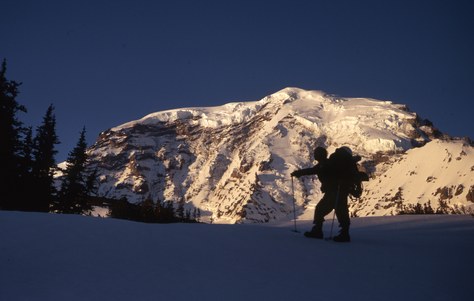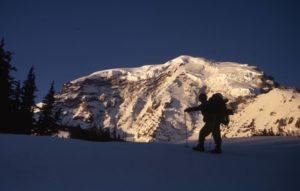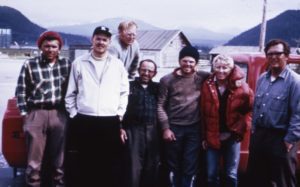Nearly 400 people have been members of The Mountaineers for 50-years or more. Together, they share 20,000 years worth of outdoor memories: exploring, learning, and conserving in our wild places. I have the privilege of learning about their stories on a weekly basis.
One such epic arrived to us via Eddy Boulton, a second generation Mountaineer and daring explorer of PNW mountains. In 1971, he and Jim Wickwire (the first American, along with Lou Reichardt, to summit K2) shared a harrowing ordeal on Mt. Rainier. They barely lived to tell the tale.
Eddy and Jim shared their accounts of the climb with us for a feature in Mountaineer magazine. While the bulk of the credit for this piece goes to Eddy, I had the pleasure of weaving their details together and took great care in editing this piece. I am so in awe of their accomplishment. The resolve and will to endeavor leaves a lasting reminder to us all about the power of the human spirit.
This article originally appeared in the Spring 2018 issue of Mountaineer magazine. To view the original article in magazine form and read more stories, click here. It’s also published as a blog on The Mountaineers website.
The wind is howling; it’s pitch dark, and heavy snow is blowing sideways. I stagger, trying to stay on my feet while Jim shouts at me from the bivouac to get in. Struggling in the gale, I lift one leg, try to step into the sack, and am blown flat on my side. I get up and try again. “If you don’t get into the sack, you’re going to die,” I think.
Jim and I lay still as the snow rapidly piles onto our bodies, turning into a suffocating weight. I’m exhausted from the exertion, and we’re both shivering violently, slipping into the first stages of hypothermia. If our temperatures continue to drop (below 93 degrees Fahrenheit), we will face complete mental and physical breakdown, and ultimately death. Gasping for breath, I feel as if I’m being chased by devils who won’t let me rest.
Our bodies will probably be found later I think, in August perhaps, as the snow melts away. No one knows where we are on this huge 14,410-foot mountain. Strangely, I feel little fear or regret.
A DUBIOUS INVITATION
It was May 15, 1971. Jim invited me to climb with him back in January, and what I didn’t know at the time was that Jim had considered other climbers, who were not available, before calling me. At 44, with little history of difficult climbing, I was a second-rate partner. But Jim and I had become friends through The Mountaineers and he trusted me. I was flattered by his invitation and said yes to the chance to do something remarkable.
I should mention my friend Jim is none other than Jim Wickwire, well-known mountaineer and author. He made the first ascent of the Willis Wall by its East Rib in 1963, and he and Alex Bertulis made the first ascent of what Alex called “the Brummel Buttress” a few years later — both challenging routes on Mt. Rainier. Later, Jim was a member of the first American team to climb K2, known as the most dangerous mountain in the world. It is a mountain that has claimed many lives and only a few hundred have reached the top. Jim came close to death when he was benighted, alone, near the summit with only a bivouac sack.
For our climb, Jim wanted the classic route: the Willis Wall. It runs straight up the north side via the Central Rib and is considered one of the most dangerous routes on the mountain. While the Willis Wall is not technically difficult by today’s climbing standards, it poses significant risk. A great overhanging ice cliff about 300 feet high, originating from the summit ice cap, looms ominously above the 4,000 -foot wall. The wall is so steep that the falling ice, breaking from the cliff above, falls straight down to form the head of the Carbon Glacier nearly a mile below. The danger is unavoidable. Chunks of ice bigger than Volkswagens break off frequently without warning night or day, all year round.
During summer and dry periods in winter, the Wall is too steep for the snow to accumulate, and the black face can easily be seen from Seattle 60 miles away. Liberty Ridge, to the right of the Wall, is the route of ambitious climbers due to its relatively safe position along a prominent ridge. It was first climbed in 1935 by Ome Daiber, Arnie Campbell, and Jack Borrow and was known as “Suicide Ridge.” No one at the time even thought about climbing the Willis Wall. I heard of Willis Wall in 1938 when I was 11 years old from my brother Bill, who attended The Mountaineers climbing course with Fred Beckey. Fred, may he rest in peace, was a cautious climber with over 1,000 first ascents and never considered climbing such an objectively dangerous route.
Twice that spring I made summit climbs of Mt. Rainier to get into better physical shape. Jim, being confident of his strength, ability, and experience, did little to prepare, as he was busy with his work on the Alaska Native Land Claims Act.
AN AUDACIOUS START
Leaving Seattle at 4:30am on our fateful morning in May, we head toward Ipsut Creek Campground at the foot of the Carbon Glacier. We stop by Charlie Crenchaw’s house to pick up stove cartridges and advise him of our plan. Charlie is active in Seattle Mountain Rescue and was the first African American to summit Denali. Later that weekend, he will help coordinate our rescue attempt.
Halfway across the 520 Bridge we realize Jim doesn’t have his double boots. A quick U-turn in the middle of the bridge takes us back home; then once again, we’re on our way.
The weather prediction is ideal. Driving toward Enumclaw at dawn, I snap photos of the north face in all its glory under blue skies. We’re excited to begin hiking up the moraine toward the snout of the Carbon Glacier in windless conditions. We carry snowshoes, but never need them. In the afternoon we move to the moraine and build camp in the sunshine.
The next morning we wake early and walk the rest of the way up the Glacier over the frozen snow with no difficulty. We make camp at the northeast side of Curtis Ridge, which separates the Carbon and the Winthrop Glaciers, and rest for the afternoon. Our first two days on the mountain have been glorious.
THE WILLIS WALL
We leave our snow camp before midnight, heading for the smaller of two avalanche cones at the foot of the wall. Cones form when falling ice and snow accumulate at the bottom of the gullies of the central rib. We have to climb one of the cones and get over a bergschrund to continue up the Willis Wall. With no way across the gaping ‘schrund, we traverse to the larger cone a hundred feet away. Hoping it will ‘go,’ we climb the cone and jump the gap, clinging to the vertical ice wall on the other side. On the morning of our third day, we are finally on the Willis Wall.
I hear a whistle in the dark, high overhead. When pieces of rock or ice fall from great heights, they ricochet, spin, and emit fearful shrieks, whistles, or buzzing sounds as they fly. Jim thinks they sound like a 105mm howitzer shell. You wonder if the next one might find you. I try not to worry. You won’t hear it before it hits you, so the ones that whistle are passing safely.
Jim leads the steep snow gully through the dangerous icefall. We move fast. About 300 feet up, I spot a ledge covered with snow to our left and call out, “Jim, I think this is our escape ledge!” I studied the route carefully the day before. He agrees to get out of the gully and onto the rib despite our quick upward progress. We attain the highest part of the rib and hear a faint noise. We look up to see a puff of smoke in the starlight. Within seconds, an ice avalanche is roaring down the gully where we had been climbing only moments ago. Chunks of ice ricochet hundreds of feet high and whistle over our heads as we flatten ourselves on the snow. Even ribs don’t offer good protection from ice avalanches.
Then, just like that, the shower is over.
We climb on at a steady pace, taking notice of the stars disappearing as clouds form overhead. We don’t know it, but an ominous front is rapidly approaching.
We focus on our task at hand. The snow is icy and hard. The 1971 spring thaw had come early, melting and refreezing the upper mountain and making it impossible for us now to jam the shafts of our ice axes in to make belay anchors. We chop small holes instead, placing our ax picks in them as anchors to form a belay. As Jim climbs, I pull up the rope and pass it over the ax; then, as he passes me and continues up, I pay out the rope as he climbs. We have no additional anchors. The rope is 150 feet long, so if Jim falls near the top of his lead, he will tumble about 300 feet before the rope stretches taught. It’s doubtful that our ice axes will stop a fall like that, so our efforts amount to little more than a psychological belay.
As we leapfrog up the wall, the clouds roll in and it begins to snow. We reach a vertical rock cliff sheathed in verglas ice. I wait while Jim reconnoiters around to the left, making best of a very poor belay stance. After a long wait, I get a cramp and straighten up, letting go of the ax and rope for only a second. At that very moment, Jim slips on the ice and falls. With a desperate one-handed lunge he spears the ice with his Penberthy Thunderbird ice ax. The extreme-angled pick catches… and holds. Our old traditional Austrian axes would NEVER make a stop like that. The Thunderbird, a prototype given to us for testing by Larry Penberthy, an old friend and climber, saves us both.
We’re both unnerved by the near disaster, but persevere because we have no other choice. We can’t go down from here. Jim leads more vertical verglas rock 30 or 40 feet and calls me up to a ledge. Jim was here eight years prior with Ellensburg climber Dave Mahre, and they named this ledge the “Traverse of the Angels.” It leads to a small tunnel in the volcanic rock leading to a gap between the upper and lower ice cliffs. It’s the only way through to the summit. And it’s completely blocked with ice.
A coal miner in my youth, I am undeterred. I swing my ax furiously, throwing great chunks of snow and ice over the cliff and down the mountain. I drop my pack and crawl into the newly exposed tunnel. Easier ground lays on the other side. With two packs to carry, Jim has a much harder time negotiating the tunnel. I hold him fast on belay as he crawls through the tunnel, pushing my pack and pulling his own.
 ED CLIMBING THE WILLIS WALL WITH OLD BOOTS AND OLD GRIVEL CRAMPONS (HE COULDN’T CLIMB ON FRONT-POINT – HIS CRAMPONS FLEXED). EVERYTHING WAS ICED OVER. PHOTO BY JIM WICKWIRE.
ED CLIMBING THE WILLIS WALL WITH OLD BOOTS AND OLD GRIVEL CRAMPONS (HE COULDN’T CLIMB ON FRONT-POINT – HIS CRAMPONS FLEXED). EVERYTHING WAS ICED OVER. PHOTO BY JIM WICKWIRE.
Finally, we’re safe and done with the difficult and dangerous climbing. And we’re exhausted. About 50 feet below, I spot a small hole in the snow. Guessing it might lead to a moat, we descend and dig, finding a fine place to bivouac. During the night, ice thunders over our heads. We get very little sleep, but at least we’re safe in our little hole.
THE STORM
On the morning of day four we emerge to find low wind and quickly accumulating snow. Jim leads a steep and tenuous section for about 300 feet. When the slope eases I get in front, where I face an uphill struggle to kick steps, alternatively sinking up to my knees, waist, and armpits. It’s the definition of wallowing, and we are not moving fast enough. Jim takes over with his longer legs and fights for five and a half hours until we reach the crest of Liberty Ridge.
It takes us nine hours to climb 1,000 feet. Jim is utterly exhausted from his efforts. We spend two hours taking turns building a snow cave, alternatively working to delicately balance overheating and shivering. We crawl in and the roof collapses. With strong winds and heavy snow, we start another cave in the dwindling light.
The second cave is very small, much smaller than the first. I sit next to the opening and focus on keeping it clear as the blowing snow fights to pack our entrance shut. Claustrophobia slowly possesses me. I nearly died in an avalanche burial six years prior on Mt. Robson in the Canadian Rockies. Suddenly I have to get out! With no thought, I begin thrashing and burrowing through the packed snow toward the entrance. Jim tries to stop me but I am obsessed with escape. When I emerge I am blown off my feet by the high winds, which are gusting at 70-80mph. Jim is nearly buried in my animalistic escape but manages to crawl out behind me with the bivouac sack. That’s when he shouts at me to get back in.
The bivy sack offers little protection. We shiver violently. Time is standing still. As hypothermia takes over, our shivering slows and eventually stops. I have no recollection of how we came to be sitting in the snow with the remnants of the bivy sack wrapped around our shoulders.
THE DESCENT
Mercifully, dawn comes. The sun pokes out at us through the dying storm on the morning of day five to reveal a ground blizzard blowing across the summit saddle. I’m fascinated watching the whole surface moving like a thick, white river.
We sit motionless. Jim is having auditory and visual hallucinations, and I begin imagining helicopter noises. Realizing we need to move or die, I dig a frozen orange out of my parka pocket and break it into sections. I push orange into Jim’s mouth, and then into mine, until it is gone. I find stale peanuts in a pocket and feed them to Jim one at a time. Still famished, I eat the orange peels too.
I retrieve our crampons and put them on Jim’s boots, then my own. I try to pull the climbing rope out of the snow, but it has frozen solid. I simply don’t have the strength to pull it loose or dig it out, so I untie it from my waist and drop it. Jim tries to rescue my pack from the bivy hole, but it too is frozen into the mountain. I pick up Jim’s pack, stuff the bivy sack into it, sling it over my shoulder, and help Jim up. “Come on, let’s go.”
Punching steps in the snow, I slowly guide us toward the Emmons Glacier. I make it only a few steps when I hear Jim cry out. He’s collapsed. He gives me a desperate look as I help him up and put his arm over my shoulder. We wind our way across the top of the Winthrop Glacier icefall in the direction of the Emmons Glacier: the easiest way down the mountain.
The ground blizzard is still blowing snow down the mountain, and having no climbing rope, I worry about the snow-concealed crevasses. I observe that chunks of frozen snow are blowing down the mountain, visible unless they drop into a crevasse, so I carefully proceed down following the chunks.
It takes us six hours to get to Schurman Hut.
We find its outwards opening door buried in snow and frozen shut. The only window has a broken pane, so by working through the hole I manage to get the window open and crawl in. The bunk next to the window is covered with a large mound of snow that had blown through the broken pane. I jam the door open by shoving from the inside. It’s done. We’re safe.
IT’S NOT OVER UNTIL IT’S OVER
Schurman Hut, named after an early Mt. Rainier guide and Boy Scout leader, was built by dozens of volunteers, including Ome Daiber who helped create Mountain Rescue, in the early 1960’s. It’s built of steel tunnel liner covered with cemented rocks and serves as a climbers’ refuge for emergencies. During the climbing season, it’s used by climbing rangers. In it, I find a two-burner Coleman stove, five gallons of stove fuel, a candle, a half-book of paper matches, a can of Spam, some dry milk, and coffee. We also find a radio with batteries too cold and weak to transmit, but we can hear the rangers ticketing cars without chains.
The storm, which had died considerably during our descent, comes back in full fury. Jim is very tired and doesn’t get up much for two days. I busy myself making toasted Spam and coffee and searching for more supplies. At the rear of the hut I find a steel locker with a brass National Park Service padlock made by the Best Lock Company. I beat on the lock with my ice hammer until it gives. Inside I find treasure: big, 5-gallon tin cans of emergency food! I keep what remains of the lock.
Using the big mound of snow by the window as a water source, I cook for two days, mostly soup and dried potatoes, and the hut warms to 25 degrees Fahrenheit. At night, we snuggle together on a bunk under an old, rotten tent.
On the second day in the hut, we decide to make a run for it. We make it as far as the door where the wind literally blows us over, gusting at 90-100mph. Back inside we go.
At 4:30pm on the third day in the hut, we hear the wind die down at long last. We grab what little gear we have and start for Glacier Basin. By midnight we reach White River Campground, completely exhausted. Unable to wake the ranger, we sleep on the dry Ranger Station floor for a few fitful hours.
Too cold to sleep any longer, we resume our march toward home. All night I punch steps in the snow. By dawn we arrive at the Park’s White River entrance, some 20 miles from Schurman Hut. We flag down a snowplow on Highway 410, and the driver takes us half a mile down the road to a working phone.
Jim calls the Mount Rainier Park Superintendent, who’s relieved to learn of our return. An Army helicopter had been waiting for days for a break in weather to come searching for us, and was just about to depart. We are taken to Jim’s car at Ipsut Creek where we we’re greeted by six of Jim’s friends who marched all the way up the Carbon Glacier to look for us. It’s our eighth day on Rainier, and we are finally safe.
EPILOGUE
All this happened 47 years ago, but the memory is as vivid as if it were yesterday. I’ve been lucky to survive 7 or 8 near-death experiences, but none as profound. If not for the Penberthy ice axes, or the break in the weather at the summit, our bodies would have been found later — just as Bill Loki discovered my pack in August 1971. I found Jim’s climbing rope, too, in July when I led a Mountaineers climb of Ptarmigan Ridge.
Jim and I never climbed together again. He went on to do important Himalayan climbs, and in 1972 I married Hille Harms, a climber, skier, kayaker, and artist, and I never did risky climbs again. But I cherish my memories and remember my old friends, including Jim and Mary Lou Wickwire, and will always hold a special place in my heart for the Willis Wall.
 LEFT TO RIGHT: HOWARD ANDERSON, BILL LOKI, FRED DUNHAM, ED BOULTON, JIM WICKWIRE, FRED STANLEY, BARRY PRATHER (ON ‘63 EVEREST EXPEDITION). THEY ALL CAME TO FIND JIM AND ED BECAUSE THERE WERE NO PARK SERVICE MOUNTAIN RESCUE SERVICES. THEY CAME UP THE CARBON SIDE. PHOTO BY GENE PRATER.
LEFT TO RIGHT: HOWARD ANDERSON, BILL LOKI, FRED DUNHAM, ED BOULTON, JIM WICKWIRE, FRED STANLEY, BARRY PRATHER (ON ‘63 EVEREST EXPEDITION). THEY ALL CAME TO FIND JIM AND ED BECAUSE THERE WERE NO PARK SERVICE MOUNTAIN RESCUE SERVICES. THEY CAME UP THE CARBON SIDE. PHOTO BY GENE PRATER.
 ED CLIMBING THE WILLIS WALL WITH OLD BOOTS AND OLD GRIVEL CRAMPONS (HE COULDN’T CLIMB ON FRONT-POINT – HIS CRAMPONS FLEXED). EVERYTHING WAS ICED OVER. PHOTO BY JIM WICKWIRE.
ED CLIMBING THE WILLIS WALL WITH OLD BOOTS AND OLD GRIVEL CRAMPONS (HE COULDN’T CLIMB ON FRONT-POINT – HIS CRAMPONS FLEXED). EVERYTHING WAS ICED OVER. PHOTO BY JIM WICKWIRE.








